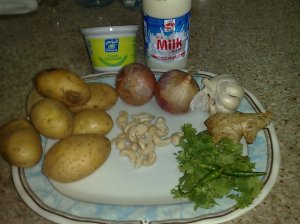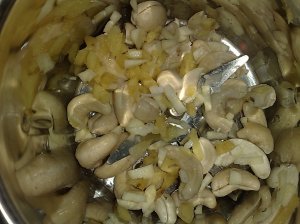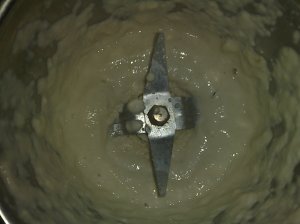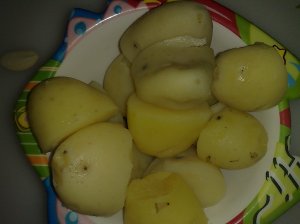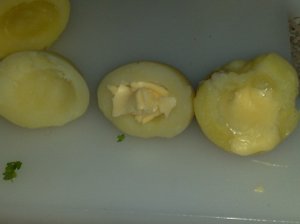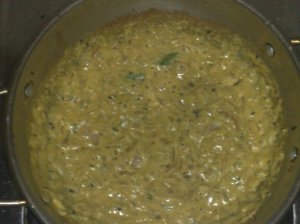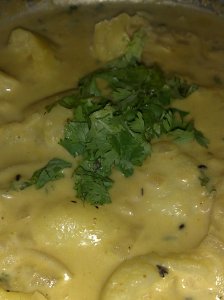Or rather Peas & Cheese
Or as the British would have it .. Muttah pan-Knee-yur!
This recipe is also from Nigella Lawson. It’s from the same show as the pomegranate raita. I usually avoid paneer altogether. But, I haven’t seen paneer dancing with peas in a long time. So I thought, let’s turn on the gas stove and make us some paneer.
This recipe started with a disaster I can never forget. After I paid the bill for all the other ingredients, I realized that all the groceries around my house were out of stock on paneer. If you know me, you know that if I’ve decided mutter paneer, then nothing else can take it place. So after some googling I found out there were cheese substitues that I could use in it’s place. So I headed back to the store, and hello hello! There was plain, hallomi, feta, labneh and what not. Also, a lot of these packs had some ingredient called Cow’s Rennet. I did some googling from my mobile and found out this :-
Cheese is made by coagulating milk to give curds which are then separated from the liquid, whey, after which they can be processed and matured to produce a wide variety of cheeses. Milk is coagulated by the addition of rennet. The active ingredient of rennet is the enzyme, chymosin (also known as rennin). The usual source of rennet is the stomach of slaughtered newly-born calves.
Whoops! That was scary! Stomach of a slaughtered newly born calf? No thank you! Just when I was about to give up, I read the next line –
Vegetarian cheeses are manufactured using rennet from either fungal or bacterial sources. Advances in genetic engineering processes means they may now also be made using chymosin produced by genetically altered micro-organisms.
God bless genetics! I checked some more packs and found one that said – “Rennet cultured from microbes”. I did a little jig. What I had forgotten in my excitement was that I should have also googled whether the cheese melted under fire, or burnt. I didn’t. My bad! I came back home and tried heating the cheese cubes and watch my dreams melt away with them cubes.
Day 2. Went looking further. In between calls to Chandrasur and 2kgwala, I managed to locate a shop selling paneer. One kilo of it. Amul Frozen Paneer. I actually heard the “Amul .. The Taste of Indiaaaaaa” in my head when I picked up the pack. 10 minutes later, go – time!
Muttar Paneer
What you will need:-
1/2 cup vegetable oil
250 gms paneer
1 onion, halved  2 cloves garlic, roughly chopped
2 cloves garlic, roughly chopped
1-inch piece ginger, roughly chopped
3 teaspoons of salt – adjust for your taste
1 teaspoon turmeric
1 teaspoon garam masala
500gm packet frozen peas
1 teaspoon tomato puree
1 cup vegetable stock (I used 2 cups water for this)
Let’s Do This!
The first thing you can do is prepare the paneer cubes. I opened my 1 kg pack to find two 500 gm packs inside. Which meant I needed to break one of them to get my 250 gms. 2 knives, a hammer and a screwdriver gave me all they had, but alas! I could barely dent the surface. The instruction was to let it thaw for 30 mins. I couldn’t wait that long. I put in my microwave at Med. low for 6 mins, and voila! The knife ran through it smooth as butter..er..cheese. Careful though. You shouldn’t put back in to the freezer stuff that was frozen before and thawed. Keep such items in the fridge. Once you manage to get a chunk of paneer, cut them into darling 1″ cubes like this.
Heat the oil a large pan and add the paneer cubes, in 2 batches, and fry until they are golden. The paneer will give out some water when heated, and given that there is no love lost between Mr. Oil and Mr. Water, you may want to get an apron and some glasses on. Fry them on one side ..
And then flip each of them over to fry the other, so that you have something that looks like a grilled sandwich.
Remove the golden cubes to a double thickness of kitchen towel. It is possible to dry fry the paneer cubes in the pan with no oil, to avoid the oil splashing you. Then continue with the recipe below.
Pour all but about 2 tablespoons of the oil out of the pan. Put the onion, garlic cloves, and ginger into a food processor and blitz to a coarse pulp. Should look like this..
 Fry gently for about 5 minutes with a sprinkling of salt. Stir in the garam masala and turmeric and cook for another 2 minutes before adding the still frozen peas. Dissolve the tomato puree in the vegetable stock and pour over the contents of the pan. Stir again and turn the heat down to low, cover with foil or a lid.
Fry gently for about 5 minutes with a sprinkling of salt. Stir in the garam masala and turmeric and cook for another 2 minutes before adding the still frozen peas. Dissolve the tomato puree in the vegetable stock and pour over the contents of the pan. Stir again and turn the heat down to low, cover with foil or a lid.
Before ..
Cook for 15 minutes, tasting to check that the peas are tender.
After..
You can cook muttar paneer up to this stage, if you like, uncovering and then reheating gently with the diced, oil-crisped paneer, or proceed directly now. In which case, take off the foil and add the paneer cubes to warm them through before serving.
Do that and you have –






